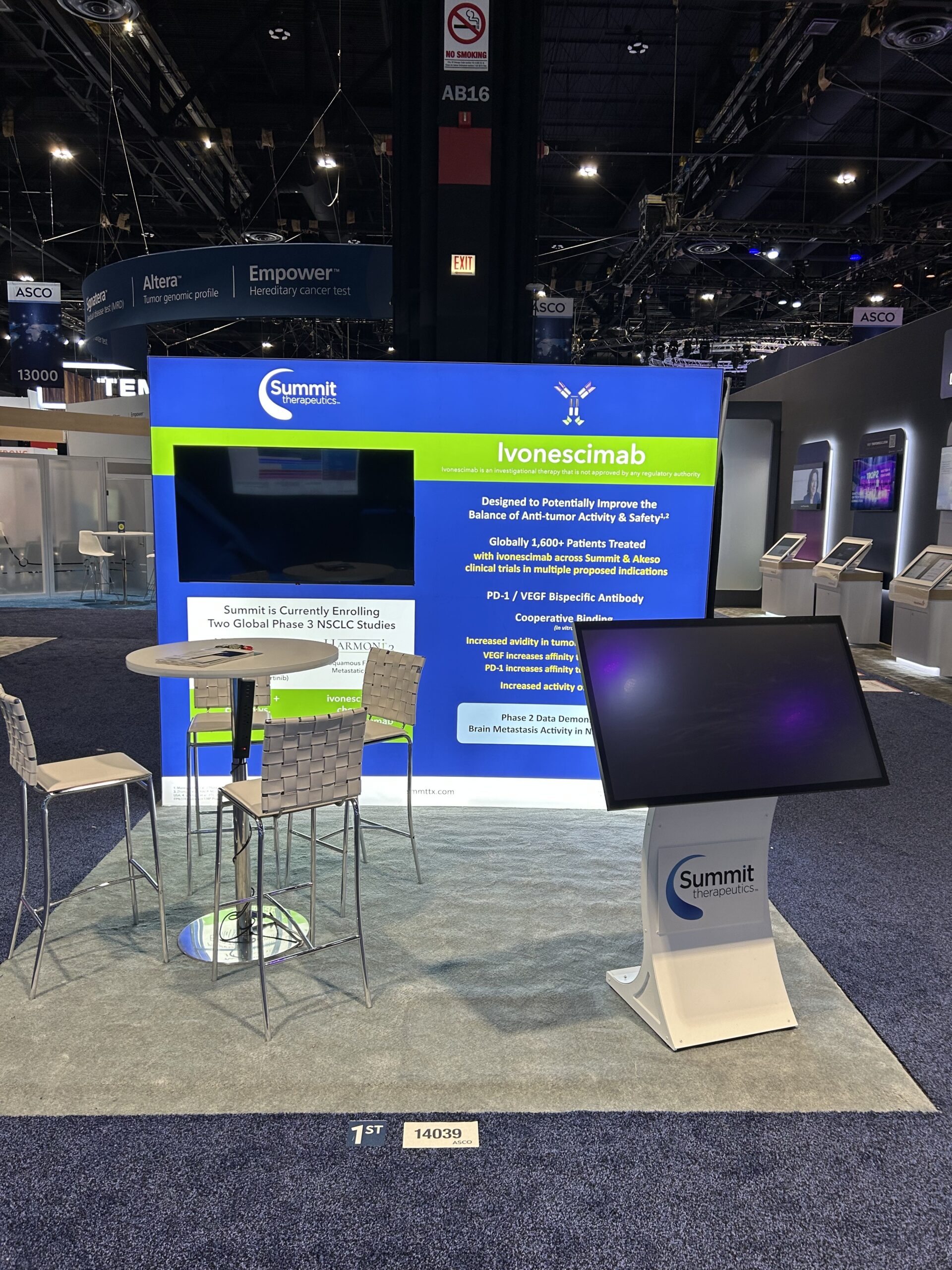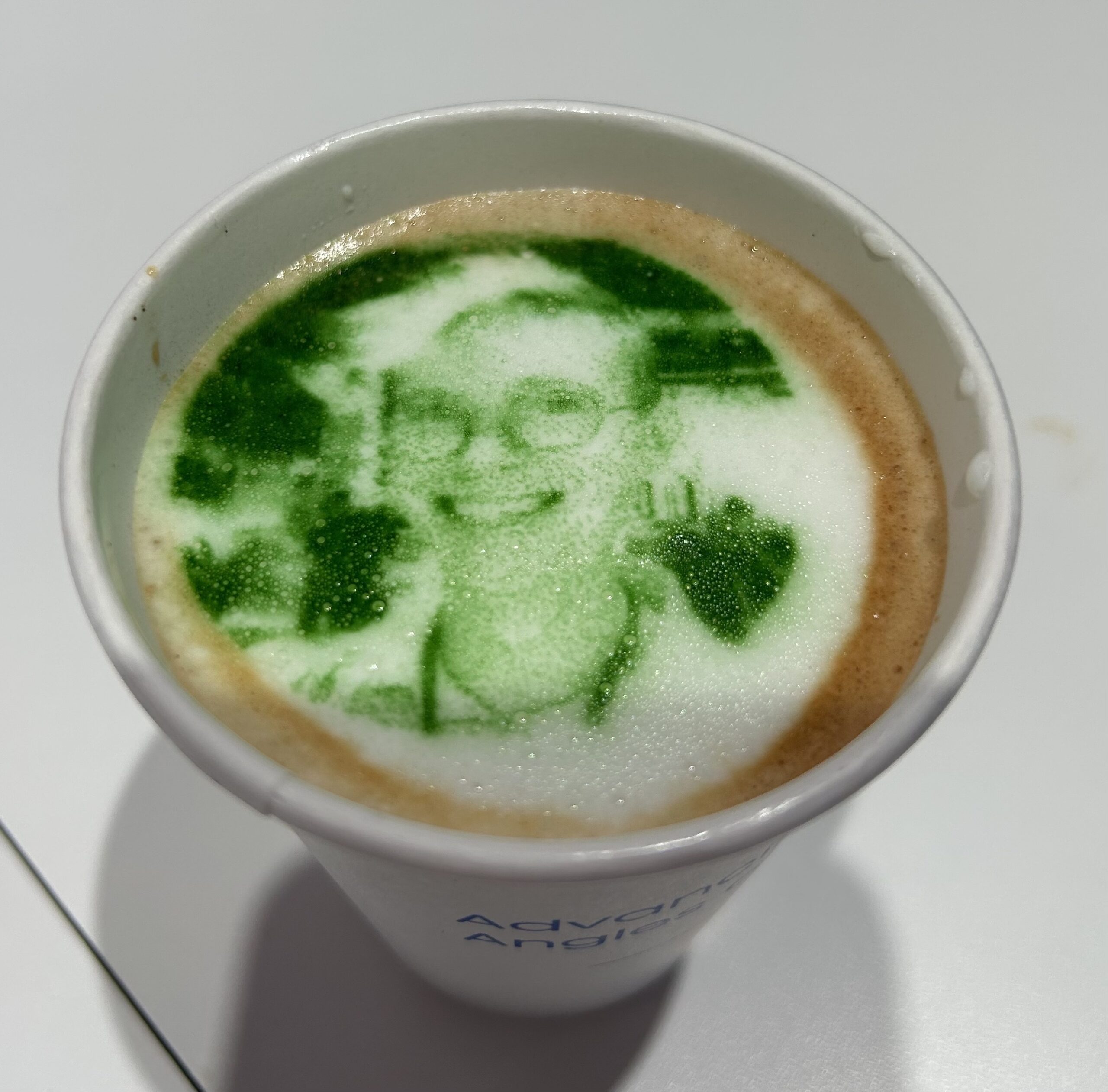CHICAGO – More than 40,000 clinicians, biopharma executives, investors, drug salespeople and many others involved in cancer research descended upon McCormick Place in Chicago for the American Society of Clinical Oncology’s annual meeting.
Large pharmaceutical companies dominated the late-breaking data sessions, sharing insight into why an antibody-drug conjugate failed, how another could return to the market and the promise of new lung cancer medicines. Novartis also shared more details about its third-generation chronic myeloid leukemia drug.
 Summit’s booth. Photo by Kyle LaHucik
Summit’s booth. Photo by Kyle LaHucikBetween the much-anticipated data readouts, attendees could be found perusing the hall of posters and the labyrinth of drugmaker booths, which were all strikingly different. Summit Therapeutics, which saw its stock skyrocket on the eve of the meeting thanks to a Keytruda-beating result, had a small section, with four chairs and one table. Nearby, Merck could likely fit an entire late-stage, randomized trial population in its sprawling section.
Unlike in 2022, when a multibillion-dollar deal kicked off the year’s most important cancer confab, there was no oncology M&A chatter at this year’s ASCO event.
Here’s what else we noticed at this year’s meeting:
Five years later, Lilly has a brand-new cancer pipeline: To kick off Lilly’s investor event on Sunday evening, Loxo@Lilly president Jake Van Naarden rewound the clock to 2019, when the company first acquired Loxo Oncology (where Van Naarden had previously been chief operating officer). “We took the bold initiative in the first couple of months assuming these roles to terminate nearly [the] entire pipeline,” Van Naarden said.
In the ensuing years, Lilly revamped its cancer pipeline, but some wonder if its enough.
At the event, TD Cowen analyst Steve Scala asked Van Naarden about oncology’s future contributions to Lilly’s revenue. “That likely will be a single-digit percentage in a decade — so relatively small contributor,” he said. “You sit on the Lilly executive committee, so you’re privy to the ten-year plan. Is that likely how it plays out? Or are we underestimating oncology or overestimating something else?”
Van Naarden’s response? Lilly is and will continue to make billions of dollars from its obesity and diabetes medicines, which it can then invest in other areas like cancer. — Lei Lei Wu
It’s all about multi-regional trials: Rick Pazdur, FDA’s oncology leader, emphasized once again that he wants multi-regional studies in approval submissions when he was asked about China-only trials at a STAT event. And that means having quality sites across the world, not 90% of sites in one country and the remaining 10% in countries that people in the audience couldn’t point to on a map, he said. — Kyle LaHucik
 Phuong Khanh Morrow
Phuong Khanh MorrowNovartis’ CML data generate excitement: The company reported Friday that Scemblix performed better than Gleevec and other second-generation agents treating chronic myeloid leukemia. “I was practicing at the time of Gleevec, and so seeing that complete evolution now to where we’re at third-generation TKIs that are demonstrating durable responses and the hope for cures in the future — it’s exciting,” Phuong Khanh (PK) Morrow, head of Takeda’s oncology therapeutic area, told Endpoints News. — Kyle LaHucik
The latest on KRAS: Shortly before ASCO, Endpoints reported that Novartis terminated its Phase 3 KRAS inhibitor, citing “increasing options available to patients.” It came as a shock to Merck, which recently entered Phase 3 with its own KRAS inhibitor. “I was surprised. I have no idea why they did that,” Merck Research Laboratories CMO Eliav Barr said in an interview. Merck plans to build a “broad program” for its oral KRAS G12C asset, called MK-1084, and it also has other KRAS drugs in the works, Barr said. Eli Lilly also presented Phase 1/2 data this week for its experimental KRAS therapy, called olomorasib. — Kyle LaHucik
The color of Pfizer’s couches looked … Merck green: There was plenty of blue in Pfizer’s section, but the couches appeared to be the same color green that Merck has long used. Meanwhile, Sanofi went for purple in its booth. Its hometown, Paris, is hosting the Olympics this summer, and runners will race on a track with a similar shade of purple. — Kyle LaHucik
Lilly’s lunch special: The Midwest pharma giant was doling out Italian beef sandwiches in its booth. Chicagoans, like myself, appreciated the local flavor. But Aaron Mitchell, an oncologist from Memorial Sloan Kettering Cancer Center who studies conflicts of interest between doctors and industry, tweeted his concern about industry-supplied food at the meeting. “I’m not condemning anyone who ventures into Pharma Disneyland to fill their stomachs,” he wrote on X. “But let’s at least pause for a moment to think about WHY these companies do this.” — Kyle LaHucik
PIPEs may be here to stay: Bicycle Therapeutics raised $555 million from a stock sale to private investors in one of the biggest PIPEs of 2024 right before ASCO. Endpoints caught up with CFO Alethia Young, who predicts that the days of raising money after data readouts are over for now. “I hope they come back, but I wouldn’t bank on it,” she said. — Lei Lei Wu
Will there be ADC biosimilars? It’ll be tough: Executives at antibody-drug conjugate developers said it would be tough to make biosimilars of the hot cancer modality given the many components, variability in clinical efficacy and safety of current agents.
“Whether generic companies find that to be attractive, I don’t know. I’m sure they will, but it won’t be easy,” Merck’s Barr said. “It’s not undoable. There’s Humira biosimilars and all that. The antibody, they can do it. The question is the linker, the drug-antibody ratio, the stability of the linker.”
“It’s orders of magnitude harder than naked antibodies. But if you have a drug like Enhertu, and it’s going to be what we all believe it is going to be now,” said Daiichi Sankyo CEO Ken Keller. “There’s a lot of smart people in the world, and so we’re planning for life after Enhertu.” — Kyle LaHucik and Lei Lei Wu
 Name that Endpoints reporter.
Name that Endpoints reporter.Your picture in latte foam: To stay awake amid the meeting’s hoopla, take a look at your face. No, literally. At Amgen’s booth, they’ll take a live photo and somehow turn it into latte art to go along with your caffeine kick. — Kyle LaHucik